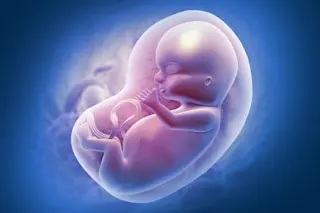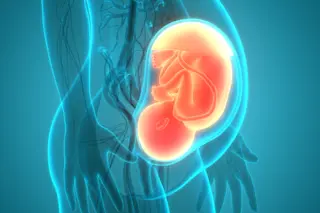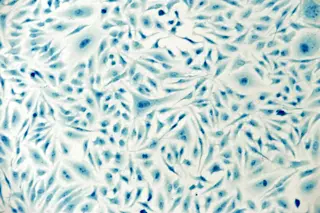The Pith: When it comes to the final outcome of a largely biologically specified trait like human height it looks as if it isn't just the genes your parents give you that matters. Rather, the relationship of their genes also counts. The more dissimilar they are genetically, the taller you are likely to be (all things equal).
Dienekes points me to an interesting new paper in the American Journal of Physical Anthropology, Isolation by distance between spouses and its effect on children's growth in height. The results are rather straightforward: the greater the distance between the origin of one's parents, the taller one is likely to be, especially in the case of males. These findings were robust even after controlling for confounds such as socioeconomic status. Their explanation? Heterosis, whether through heterozygote advantage or the masking of recessive deleterious alleles. The paper is short and sweet, but first one has to keep in mind the long history of this sort of research in the murky domain of human quantitative genetics. This is not a straight-forward molecular genetic paper where there's a laser-like focus on one locus, and the mechanistic issues are clear and distinct. We are talking about a quantitative continuous trait, height, and how it varies within the population. We are also using geographical distance as a proxy for genetic distance. Finally, when it comes to the parameters affecting these quantitative traits there are a host of confounds, some of which are addressed in this paper. In other words, there's no simple solution to the fact that nature can be quite the tangle, more so in some cases than others. Because of the necessity for subtlety in this sort of statistical genetic work one must always be careful about taking results at face value. From what I can gather the history of topics such as heterosis in human genetics is always fraught with normative import. The founder of Cold Spring Harbor Laboratory, Charles Davenport, studied the outcomes of individuals who were a product of varied matings in relation to genetic distance in the early 1920s. This was summed up in his book Race Crossing in Jamaica:
A quantitative study of 3 groups of agricultural Jamaican adults: Blacks, Whites, and hybrids between them; also of several hundred children at all developmental stages. The studies are morphological, physiological, psychological, developmental and eugenical. The variability of each race and sex in respect to each bodily dimension and many basis vary just as morphological traits do. In some sensory tests the Blacks are superior to Whites; in some intellectual tests the reverse is found. A portion of the hybrids are mentally inferior to the Blacks. The negro child has, apparently, from birth on, different physical proportions than the white child.
Because of the fears of miscegenation in the early 20th century scholars had a strong bias toward finding the data to confirm the assumption that admixture between divergent human kinds resulted in a breakdown and depression in trait value in relation to both parental lineages. Today this is not so. Rather, I would argue that the bias is now in the opposite direction, at least in the West. My friend Armand Leroi wrote Meet the world's most perfect mutant seven years ago. Who is the most perfect human according to Armand? She is Saira Mohan, a model of Indian, Irish and French ancestry. Armand concludes:
If deleterious mutations rob us of it, they should do so with particular efficacy if we marry our relatives. Most novel mutations are at least partly recessive, and inbreeding should accentuate their negative effects. Many weird genetic disorders come from Pakistan and Saudi Arabia, where there is a strong tradition of first-cousin marriage. Conversely, people of mixed ancestry should show the benefits of concealing recessive mutations. And this, I suspect, is the true meaning of Saira Mohan: half Punjabi, quarter Irish, quarter French and altogether delightful. She, too, is a mutant – but a little less so than most of us.
Thandie Newton masking recessive alleles
This is entirely in keeping with the dominant ethos of the global elite, which aims for a panmixia
of genes in concert with an alignment of a particular set of cosmopolitan post-materialist memes. But, as I pointed out to Armand
there are also cases where crosses between genetic backgrounds may have deleterious consequences. For example, a European specific allele in African Americans
may have a negative fitness interaction with the predominant African genetic background of this population. I am not implying here that science is fiction, a construction of our biases and preconceptions.
But the dominant cultural narrative framework does put pressure upon how we interpret science, and all the more so in domains which require a level of statistical subtlety and personal candor
. Of course now that we can see exactly how individuals are mutant at the level of the genome
Armand's supposition can actually be tested. That is, we can see how many deleterious recessive alleles are in fact masked in people of hybrid origin. That at least may plug one of the fuzzy spots in our picture of how genetic backgrounds interact in humans. I prefaced the review of a paper on marital distance and height with some history of science and a reflection of how contemporary values influence the generation and interpretation of knowledge because there's a lot of confusing material in the literature on correlations between genetic distance and trait value. There is the result that marriages between 3rd cousins seem the most fertile in Iceland
. Is this because of a balance between genetic incompatibilities and expression of recessive diseases? Or perhaps the answer lies in social dynamics, insofar as people who come from related lineages are more likely to weather difficult times in their relationship? It's one study from Iceland. But of course the minority who vociferously argue against racial amalgamation and admixture on moral/normative grounds will focus upon this specific positive empirical finding in the literature. Now, Iceland is ideal for many human genetic studies because it has excellent records and is culturally homogeneous. But at the end of the day Iceland is still Iceland. And today Poland is still Poland. I say that because this study tracks thousands of Polish youth over the years. Here's the abstract:
Heterosis is thought to be an important contributor to human growth and development. Marital distance (distance between parental birthplaces) is commonly considered as a factor favoring the occurrence of heterosis and can be used as a proximate measure of its level. The aim of this study is to assess the net effect of expected heterosis resulting from marital migration on the height of offspring, controlling for midparental height and socioeconomic status (SES). Height measurements on 2,675 boys and 2,603 girls ages 6 to 18 years from Ostrowiec Świętokrzyski, Poland were analyzed along with sociodemographic data from their parents. Midparental height was calculated as the average of the reported heights of the parents. Analyses revealed that marital distance, midparental height, and SES had a significant effect on height in boys and girls. The net effect of marital distance was much more marked in boys than girls, whereas other factors showed comparable effects. Marital distance appears to be an independent and important factor influencing the height of offspring. According to the “isolation by distance” hypothesis, greater distance between parental birthplaces may increase heterozygosity, potentially promoting heterosis. We propose that these conditions may result in reduced metabolic costs of growth among the heterozygous individuals.
As you may know, height is substantially heritable. That means that ~80-90% of the variation in the trait within the population in developed nations is due to variation in genes. This has some validity even within families. Tall parents tend to given rise to tall offspring
, though there is a variation around the expectation. In other words, siblings differ in height, in part because of environmental factors, but also in part because siblings differ in their genetic endowments from their parents. So naively one can model this like so: Height ~ Genetic endowment + Environmental contingencies The genetic endowment is a function of the mid-parent value in standard deviation units. That means you average the standard deviations of the parents from the sex-controlled mean. Let's give a concrete example. Imagine a male who is 5'8 inches, and a female who is 5'7 inches. The standard deviation for height is ~3 inches, with the American male mean being 5'10 inches and female being 5'4 inches. That means that the male is -2/3 standard deviations below the mean, and the female is 1 standard deviation above the mean. The expectation for their offspring then will be 1/3 standard deviation above the mean (5'11 for males, 5'5 for females). But because of the variation in the nature of genetics and environment, there's actually going to be a standard deviation of ~3 inches for the offspring (e.g., ~70% chance that the male will be between 5'8 and 6'2). There is also the reality that because environmental factors aren't heritable the offspring should regress somewhat back to the population mean all things equal, though in the case of height not too much because it is so genetically influenced. A few years ago I played this game with libertarian pundits Megan McArdle and Peter Suderman
, who announced their engagement. Megan and Peter are both 6'2. I estimated that the expected value is that any son of theirs would be 6 feet 3.6 inches, and any daughter 5 feet 9.6 inches. How can it be that their sons should be taller than either of them? Remember that Megan is much taller than Peter in standard deviation units in relation to her sex. Now how would expectation be altered if Megan McArdle and Peter Suderman were full-siblings? (they are not full-siblings, this is a thought experiment!) At this point even if you had never taken college genetics you might be wondering whether it makes sense to calculate an expectation for the height of the offspring of two full-siblings. You know very well that there are much more serious genetic issues at hand. Going back to the relation above, you might update it like so: Height ~ Genetic endowment + Environmental contingencies - Incest decrement Even stipulating viability of the offspring, any child of full-siblings would exhibit all the problems that Armand alludes to above. It seems likely that whatever potential their parents might impart to their offspring, the combination of their genotypes would be highly deleterious, because near kin carry the same recessives. The paper above posits the inverse effect, where outbreeding results in greater outcomes than are to be expected based on the mid-parent trait value. In this telling, height is a proxy for health and development. This seems biologically plausible in the case of humans. Individuals who marry those genetically dissimilar impart gains of fitness to their offspring by virtue of elevated heterozygosity. So now we create a new relation: Height ~ Genetic endowment + Environmental contingencies + Magnitude of outbreeding In pre-modern societies individuals tended to marry those close to them geographically. Even if cousin marriage was not normally practiced, over time clusters of villages would form networks of de facto consanguinity. In the 19th and especially 20th century much of this in the extreme cases abated in Europe because of better transport. L. L. Cavalli-Sforza documented this in Consanguinity, Inbreeding, and Genetic Drift in Italy
. Modern roads resulted in a radical drop in inbreeding in mountainous regions of the country. Some researchers have argued that this shift resulted in an increased level of height, intelligence, and health, among European populations. With that, here's a nice map from Consang.net
:
Going back to the paper, after controlling for socioeconomic status they found that: 1) The increased marital distance predicts taller height than expected, especially in boys. 2) This effect is most noticeable in boys who already have parents who are relatively tall. 3) Finally, greater marital distance seems to be correlated with greater height in the parents! The last is actually a possible reason why there's no reason to appeal to heterosis at all. This might simply be a function of assortative mating of tall individuals who are more mobile. In the paper the authors go at length about sexual selection, greater mobility of individuals who are taller, etc. But whatever the reason, this shows exactly the care which must be taken with these sorts of results. It is known for example that taller individuals seem to have higher I.Q.s, leading some to assert that the genes which control height and I.Q. variance must be the same (some of them almost certainly are if there are many loci of small effect). But, it turns out that this height-I.Q. correlation disappears within families (tall siblings are no smarter than short siblings), implying that the correlation might be a function of assortative mating. As for why there may be a sex difference, the authors suggest that heterosis may manifest at different points in the developmental arc of children. Females mature somewhat faster than males. This may be so, the sexes differ and such. But my own preference is that the original results merit a deeper and expanded examination before we posit an evolutionary story (that's not possible in a scientific paper which needs a discussion, but I'm proposing an ideal world of knowledge generation and refinement!). The empirics need to be firmed up before we scaffold it in theory. Poland is Poland, and if you troll through enough data sets there'll be millions of correlations which are publishable. And yet we are living in the age of information, so we had better get going in sieving through it. At the end of the paper the authors go in a direction which I think might yield some interesting finds in the future:
One possible limitation of our study and explanation of the results may come from the fact that we used geographical distance between parental birthplaces as the only approximate measure of offspring heterozygosity. Further studies should focus on more direct examination of individuals’ allele diversity and its influence on physiological processes. Of particular interest would be investigation of a possible relationship between the level of basal metabolic rate and individual’s heterozygosity both in general term as well as heterozygosity of specific locus. Such suggestion seems to be supported by previous studies which indicate that the variation in energy expenditure at rest is determined by substantial genetic component (Bouchard et al., 1989; Bouchard and Tremblay, 1990) and heterogeneity of gene loci (Jacobson et al., 2006; Loos et al., 2007). More studies in this regard may be crucial for a better and profound understanding of the Homo sapiens metabolism and energy budget.
Because of the advances in genomics, as well as the proliferation of social science data sets (thanks to corporations and government) I hope that we can begin breaking out of the habit of being led about by the nose by our norms in more areas of human genetics than just the study of Mendelian diseases! That's a hope. I'm not saying I'd bet money on it. Citation:
Sławomir Kozieł, Dariusz P. Danel, & Monika Zaręba (2011). Isolation by distance between spouses and its effect on children's growth in height American journal of physical anthropology : 10.1002/ajpa.21482
Image Credit: Caroline Bonarde Ucci
.













